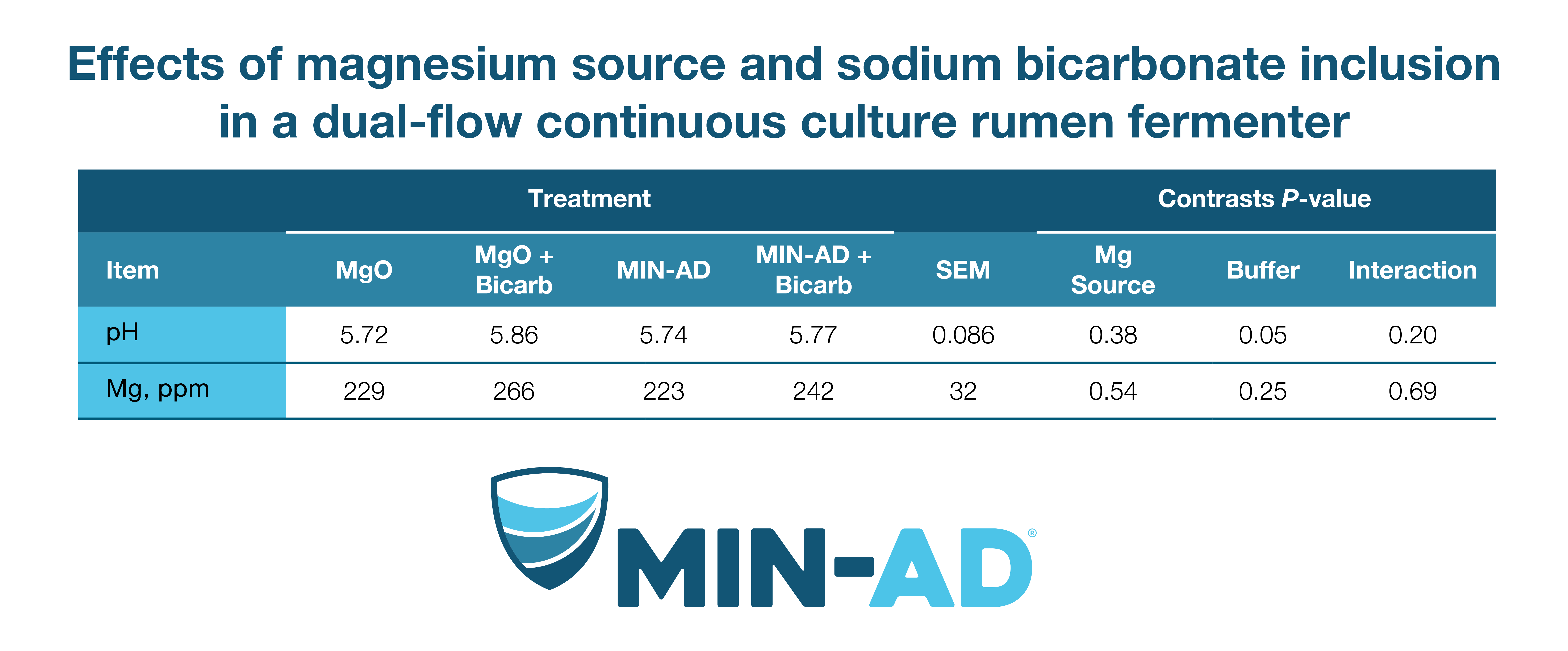Heat stress is a significant issue across much of the United States, with losses costing the dairy industry up to an estimated $1.5 billion annually1. While there are many nutritional strategies to help reduce the negative effects of heat stress on rumen pH, one of the simplest is to add dietary buffers.
“Though not typically classified as buffers, magnesium sources such as magnesium oxide (MgO) and MIN-AD®, a calcium magnesium carbonate, also affect rumen pH and can be important tools for combatting heat stress,” said Clayton Stoffel, Technical Service Manager at Papillon Agricultural Company. “These products have a slightly different mode of action than sodium bicarbonate, but they do react with hydrogen ions in the rumen and raise the pH.”
One novel way to compare buffers is using their theoretical acid consuming capacity (TACC). This value represents a product’s potential buffering capacity or the maximum amount of acid each gram of the product could neutralize. Using this method, sodium bicarbonate has a low acid consuming capacity at 11.9 mEq/g. MIN-AD has roughly double the acid consuming capacity at 21.3 mEq/g and MgO has the highest at 48.0 mEq/g. Given the strong acid consuming capacity and typical feed rates of magnesium supplements, they can be significant contributors to the buffer pack in addition to the magnesium they provide.
It is important to note that TACC values are theoretical maximums, and actual measured values can vary substantially for commercially available products depending on source, purity and processing method. The same variables can also affect magnesium bioavailability. Thus, trial work is necessary to truly differentiate between products.
Papillon Agricultural Company recently partnered with researchers at the University of Florida to compare the ruminal effects of high-quality MgO and MIN-AD, with and without the addition of sodium bicarbonate. The primary goals of the trial were to evaluate pH modulation, magnesium bioavailability and microbial growth and efficiency responses.
The trial was carried out using dual-flow continuous culture rumen fermenters fed a TMR designed to mirror high producing dairy cow diets. In this simulated rumen environment, both MgO and MIN-AD maintained similar pH levels. Adding an additional buffer (sodium bicarbonate) to both treatments resulted in small increases in pH. This provides some support for including an additional buffer in the diet when rumen pH is a concern, such as during heat stress. However, dairy cows have other strong pH modulation adaptations, like ruminal VFA absorption, that are not simulated in the continuous culture model.
In addition to the pH data, the trial produced some other noteworthy results. The concentration of magnesium in the rumen fluid was similar between both the MgO treatment and the MIN-AD treatment, suggesting similar magnesium dissolution in the rumen for both treatments. This is important because the rumen is a major location of Mg absorption in cattle, and dissolution is the first step in absorption.
During the trial, both bicarbonate and MIN-AD impacted several indicators of altered nitrogen metabolism in the fermenter. Feeding MIN-AD resulted in reduced rumen ammonia and isobutyrate concentrations, suggesting reduced protein degradation, though much more research is needed.
“Taken together, the results of this study indicate that calcium-magnesium carbonates like MIN-AD are feasible replacements for traditional magnesium sources such as MgO,” said Stoffel. “Using them in conjunction with sodium bicarbonate may have additional pH and nitrogen metabolism benefits that can improve overall herd health and efficiency.”
1 https://www.journalofdairyscience.org/article/S0022-0302(03)74040-5/pdf
Click here to view the original article on Feedstuffs.






